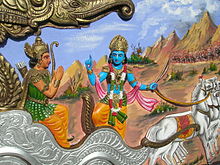YOGA
Yoga is a group of physical, mental, disciplines which originated in India. There is a broad variety of Yoga schools, practices, and goals in Hinduism, Buddhism, and Jainism. Among the most well-known types of yoga are Hatha yoga and Rāja yoga.
In Vedic Sanskrit, yoga (from the root yuj) means "to add", "to join", "to unite", or "to attach" in its most common literal sense. All further developments of the sense of this word are post-Vedic. More prosaic moods such as "exertion", "endeavour", "zeal", and "diligence" are also found in Indian epic poetry.
According to Jacobsen, "Yoga has five principal meanings:
- Yoga, as a disciplined method for attaining a goal;
- Yoga, as techniques of controlling the body and the mind;
- Yoga, as a name of one of the schools or systems of philosophy (darśana);
- Yoga, in connection with other words, such as "hatha-, mantra-, and laya-," referring to traditions specialising in particular techniques of yoga;
- Yoga, as the goal of Yoga practice."
According to David Gordon White, from the 5th century CE onward, the core principles of "yoga" were more or less in place, and variations of these principles developed in various forms over time:
- Yoga, is a meditative means of discovering dysfunctional perception and cognition, as well as overcoming it for release from suffering, inner peace and salvation; illustration of this principle is found in Hindu texts such as the Bhagavad Gita and Yogasutras, in a number of Buddhist Mahāyāna works, as well as Jain texts;
- Yoga, as the raising and expansion of consciousness from oneself to being coextensive with everyone and everything; these are discussed in sources such as in Hinduism Vedic literature and its Epic Mahābhārata, Jainism Praśamaratiprakarana, and Buddhist Nikaya texts;
- Yoga, as a path to omniscience and enlightened consciousness enabling one to comprehend the impermanent (illusive, delusive) and permanent (true, transcendent) reality; examples are found in Hinduism Nyaya and Vaisesika school texts as well as Buddhism Mādhyamaka texts, but in different ways;
- Yoga, as a technique for entering into other bodies, generating multiple bodies, and the attainment of other supernatural accomplishments; these are, states White, described in Tantric literature of Hinduism and Buddhism, as well as the Buddhist Sāmaññaphalasutta; James Mallinson, however, disagrees and suggests that such fringe practices are far removed from the mainstream Yoga's goal as meditation-driven means to liberation in Indian religions.
Bhagavad Gita
Main article: Bhagavad Gita
The Bhagavad Gita ('Song of the Lord'), uses the term "yoga" extensively in a variety of ways. In addition to an entire chapter (ch. 6) dedicated to traditional yoga practice, including meditation,[122] it introduces three prominent types of yoga:
- Karma yoga: The yoga of action.
- Bhakti yoga: The yoga of devotion.
- Jnana yoga: The yoga of knowledge.
There are numerous parallels in the concepts in ancient Samkhya, Yoga and Abhidharma Buddhist schools of thought, particularly from 2nd century BCE to 1st century AD, notes Larson. Patanjali's Yoga Sutras is a synthesis of these three traditions. From Samkhya, Yoga Sutras adopt the "reflective discernment" (adhyavasaya) of prakrti and purusa (dualism), its metaphysical rationalism, as well its three epistemic methods to gaining reliable knowledge. From Abhidharma Buddhism's idea of nirodhasamadhi, suggests Larson, Yoga Sutras adopt the pursuit of altered state of awareness, but unlike Buddhist's concept of no self nor soul, Yoga is physicalist and realist like Samkhya in believing that each individual has a self and soul. The third concept Yoga Sutras synthesize into its philosophy is the ancient ascetic traditions of meditation and introspection, as well as the yoga ideas from middle Upanishads such as Katha, Shvetashvatara and Maitri.
Patanjali's Yoga Sutras are widely regarded as the first compilation of the formal yoga philosophy. The verses of Yoga Sutras are terse. Many later Indian scholars studied them and published their commentaries, such as the Vyasa Bhashya (c. 350–450 CE). Patanjali's yoga is also referred to as Raja yoga. Patanjali defines the word "yoga" in his second sutra:
- Yama (The five "abstentions"): Ahimsa (Non-violence, non-harming other living beings), Satya (truthfulness, non-falsehood), Asteya (non-stealing), Brahmacharya (celibacy, fidelity to one's partner), and Aparigraha (non-avarice, non-possessiveness).
- Niyama (The five "observances"): Śauca (purity, clearness of mind, speech and body), Santosha (contentment, acceptance of others and of one's circumstances), Tapas (persistent meditation, perseverance, austerity), Svādhyāya (study of self, self-reflection, study of Vedas), and Ishvara-Pranidhana (contemplation of God/Supreme Being/True Self).
- Asana: Literally means "seat", and in Patanjali's Sutras refers to the seated position used for meditation.
- Pranayama ("Suspending Breath"): Prāna, breath, "āyāma", to restrain or stop. Also interpreted as control of the life force.
- Pratyahara ("Abstraction"): Withdrawal of the sense organs from external objects.
- Dharana ("Concentration"): Fixing the attention on a single object.
- Dhyana ("Meditation"): Intense contemplation of the nature of the object of meditation.
- Samadhi ("Liberation"): merging consciousness with the object of meditation.




No comments:
Post a Comment